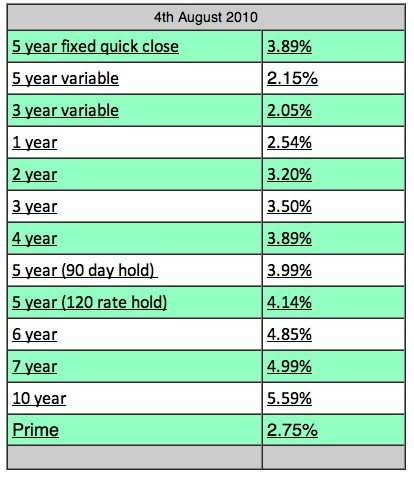Mortgage Rate Advice from Graham Connor
I was impressed by the clear info in this recent newsletter from Graham Connor, of Centum Action Mortgage:
Variable Rates:
Variable rates move in line with changes to the overnight rate set by the Bank of Canada and reflect their inflation targeting policy. July 20th saw the second increase taking Prime to 2.75%. Here are the dates for the remaining meetings this year. Consensus is for the possibility one or two further increases this year, but by no means guaranteed as the rate of recovery from the recession has already begun to cool off.
- September 8th
- October 19th
- December 7th
I reviewed the Big 5 banks’ rate forecasts back in May and compared those figures to the latest collective forecast on July 10th. The latest aggregate Prime rate forecast for the end of 2011 was 4.57%. Apply a 0.7% discount and that’s an effective rate of 3.87%. That July average rate forecast is over 0.5% lower than the average figure for the end of 2011 predicted only three months ago.
The change in the predicted rates tells us two things. Firstly, economic forecasts are subject to frequent change and are not to be taken as concrete numbers for planning so far in advance. Variable rate clients should be checking my newsletter regularly and are advised to call in at 778-389-6210 to review each situation.
Secondly, the Banks’ forecasts for future rate gains reflect global data pointing to a slower recovery than expected some months ago. For example, assuming a 0.7% discount and two further increases this year taking Prime to 3.25%, the effective rate would still be at 2.55% by the end of 2010. Read on for commentary on fixed rates (below) for those looking for the comfort blanket of guaranteed payments – now might be that time.
I recently read mortgage advice posted in an article which promoted the idea that if you think the variable rates will be higher in two years’ time than the fixed rate today, then consider locking in now. If anybody knew where rates will be in two years’ time with any degree of accuracy, that premise would be worthy of consideration. We don’t know where rates will be then, so my advice is rates should be monitored as often as once a month in the current climate.
Variable rate discounts continue to offer savings for existing clients, but fixed rates have fallen to start to close the gap. Existing variable rate clients should watch the fixed rate numbers for an indication of what they would be locking into – no need to make a move this month!
My advice to those contemplating a new variable rate mortgage:
- set payments as if you are paying rates at 5% or higher so pre-adjust to the inevitable rate increases. Increased payment all go to reduce the loan balance.
- plan your budget to see if you can manage rates above 5%
- watch my rate bulletins not only for the Prime rate increases, but for the fixed rate increases to see what you may be locking into. Set a tolerance level – I’m happy to assist in any mortgage reviews and payment plans
- variable rates best suit those with more equity in their home and those who easily qualify by the strict debt service guidelines set by mortgage lenders
- consider the hybrid mortgages to mitigate the effect of interest rate shock
- Since April 19th, expect to qualify for less on a variable rate if you have less than 20% down payment compared to a five year fixed rate
Fixed Rates
Early summer was a good reference point for fixed rates. Some lenders discounted the five year fixed rate back then to as much as 4.79%. Today, a special offer rate can be accessed at 3.89%. So, why the rate drop in so short a time?Fixed rates don’t move directly in line with central bank rate changes. Instead, fixed rates move broadly with yields on bonds for the corresponding terms. Unimpressive data from the US and sovereign debt concerns in Europe contributed to a dampening on views for a global recovery. The Bond market reacts to the news accordingly. While Canada has out-performed other G7 countries, there’s only so far to go if other countries, especially the US, do not progress. It has to be said, the extent of the slow growth outside of Canada was not anticipated. news prompted some to look out for a ‘double-dip’ recession. More recently, consensus is for a protracted period of slower growth but no ‘double-dip’.
Lenders generally look for a buffer above the bond yields. The 5 year Canada was at 2.25 yesterday. While the lenders may not collectively pull back rates any further, there is certainly no evidence of upward pressure on fixed rates today. Five year fixed rates should only be considered under 4% unless specific circumstances dictated best rates could not be achieved.
For variable rate holders who feel they missed a chance to lock in close to 4% back in April/May, an opportunity is here. The rate difference between 2.05% variable and 3.89% fixed represents the premium paid for safety and the spread may reduce further in the coming weeks. From an historical perspective, nobody would criticize a risk averse mortgage client opting for a five year fixed rate today below 4%.
Best Rates







